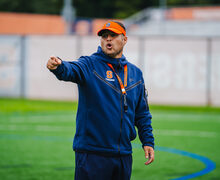Creative solutions : COLAB students utilize art and technology to combat serious social issues
Sam Thompson spends his days studying how to fight poverty and discrimination using light-up chairs and wearable technologies, merging artists with engineers and more.
The industrial design major is participating in the Collaboration Laboratory, or COLAB, an initiative by the School of Visual and Performing Arts that started last November and has students across campus using technology to further their ideas.
Along with his partner, junior Stephanie Lewis, one of the class projects included creating a pair of light-up chairs. When somebody sits on a chair it lights and when that person gets up the other chair lights up.
‘We like social interaction. We have the human side – we match mechanics to need – interested in interactions between strangers in public spaces,’ Thompson said.
The COLAB program is attempting to foster a program where students from all majors can use technology to address societal problems.
Michael McAllister, head of the COLAB program and the director of art and design for the School of Visual and Performing arts, describes the initiative as providing a new kind of education that reaches into all colleges across the SU campus.
‘It’s institutionalizing collaborative learning, anchoring it, giving it a home (in the School of Visual and Performing Arts),’ McAllister said.
Although designing the program took a lot of work and research, it didn’t seem like work for McAllister and Olivia Robinson, an industrial design major and professor of COLAB classes. Instead, they combined their thoughts and ideas with what they thought students would enjoy doing and the classes and curriculum took off from there.
‘We were looking for topics that relate to our research interests, that’s the fuel,’ McAllister said. ‘If it didn’t relate to our interests it would be excruciating, but it’s more like play.’
The COLAB facility is housed in the Warehouse downtown. However, at the moment the facility resembles something more along the lines of a junkyard or someone’s garage. Items such as a dentist’s chair, a motorcycle and a table that has a variety of wine bottles glued to the bottom are in a large studio setting because the COLAB space is currently undergoing a transition and making their space more of a home.
The program has two classes so far: Wearable Technologies and Responsive Environments.
Olivia Robinson, one of the COLAB professors said she framed Wearable Technologies around a microcontroller (a tiny computer chip that is embedded in clothing and other items on the body), sensors, emitters and other items that cover parts of the body in general to sense and gage what people do with their bodies. Robinson said these technologies are already being used in places like the military and in medicine.
‘I picked Wearable Technologies because it’s about an intersection of different disciplines, somewhere between fashion, textile art, engineering and science,’ McAllister said. ‘Who owns that? Whose area is that? The class seems like a really good fit because it’s running interdisciplinary projects – exploring and breaking new ground.’
In the Wearable Technologies class last semester, junior industrial design majors Lily Chong and Matt Kalish made elephants, which were used as communication devices that could interact with people by sending and receiving signals. The elephants ended up being featured in the New York Times’ education section for its innovation. Chong was named one of the best student designers of the year by the New York Times for her elephant design.
Other ideas that came from this project were a chair sensor, and a jacket that controlled where the wearer was touched through lighting up in areas that received contact like shoulder pads and the bottom of the coat.
Chong described COLAB as a program that brings together artists, designers, engineers and people outside those majors to create a project that helps downtown Syracuse and encourages people to come into the city.
‘Hopefully I’ll keep designing and pushing my comfort levels, and keep taking classes that push my comfort levels. The classes you learn the most from are the ones you don’t think you can do,’ Chong said.
In the future, the program wants to draw students from several other schools at Syracuse University. In this semester’s Responsive Environment class, some students from the School of Information Technology have participated.
McAllister wants more students outside of VPA to take the course. He said he would love if a poet, an architect, a designer, an artist and an engineer were all working on a team. But not all COLAB projects will be technical. The program is really about looking at ‘wicked’ problems and addressing multiple solutions at the same time to improve lives – you start where you are, McAllister said.
‘We made a grant proposal based on ‘oh my God, we had great success teaching technology to non-technical students’ and hope to extend it to community, families with disabilities,’ McAllister said. ‘This is a community-based project, a marriage of technology, interaction and community. The future of COLAB is the intention to work with what we call, ‘wicked’ problems, large social problems and find interdisciplinary solutions that are holistic.’
-Caitlin Dewey, asst. copy editor, contributed to the reporting of this story
Published on February 24, 2009 at 12:00 pm




